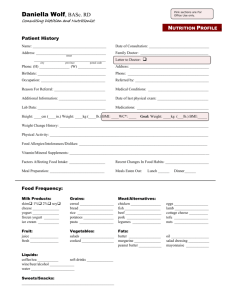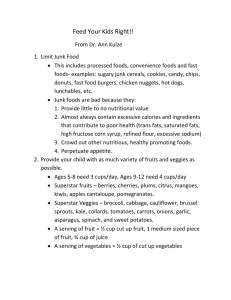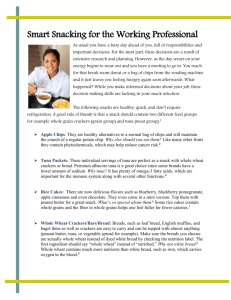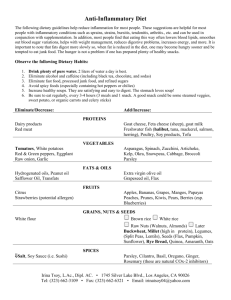Healthy_Schools_Snacks
advertisement
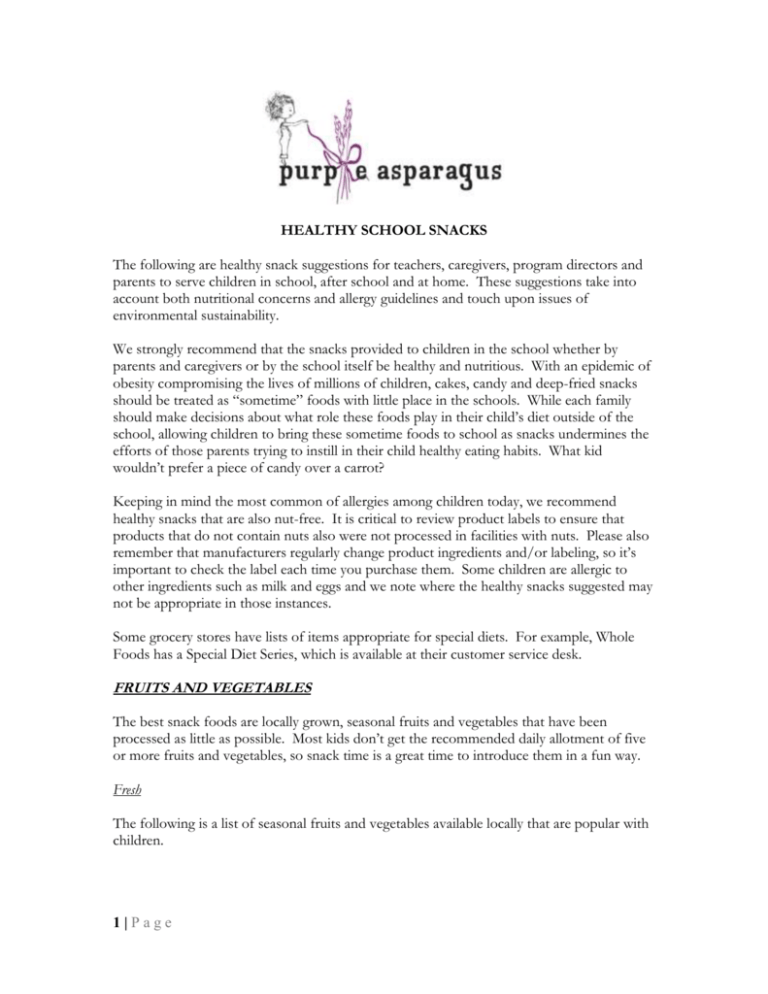
HEALTHY SCHOOL SNACKS The following are healthy snack suggestions for teachers, caregivers, program directors and parents to serve children in school, after school and at home. These suggestions take into account both nutritional concerns and allergy guidelines and touch upon issues of environmental sustainability. We strongly recommend that the snacks provided to children in the school whether by parents and caregivers or by the school itself be healthy and nutritious. With an epidemic of obesity compromising the lives of millions of children, cakes, candy and deep-fried snacks should be treated as “sometime” foods with little place in the schools. While each family should make decisions about what role these foods play in their child’s diet outside of the school, allowing children to bring these sometime foods to school as snacks undermines the efforts of those parents trying to instill in their child healthy eating habits. What kid wouldn’t prefer a piece of candy over a carrot? Keeping in mind the most common of allergies among children today, we recommend healthy snacks that are also nut-free. It is critical to review product labels to ensure that products that do not contain nuts also were not processed in facilities with nuts. Please also remember that manufacturers regularly change product ingredients and/or labeling, so it’s important to check the label each time you purchase them. Some children are allergic to other ingredients such as milk and eggs and we note where the healthy snacks suggested may not be appropriate in those instances. Some grocery stores have lists of items appropriate for special diets. For example, Whole Foods has a Special Diet Series, which is available at their customer service desk. FRUITS AND VEGETABLES The best snack foods are locally grown, seasonal fruits and vegetables that have been processed as little as possible. Most kids don’t get the recommended daily allotment of five or more fruits and vegetables, so snack time is a great time to introduce them in a fun way. Fresh The following is a list of seasonal fruits and vegetables available locally that are popular with children. 1|Page Fruits: Early Fall: Stone fruits (such as plums, peaches and nectarines), melons, blueberries, raspberries, blackberries, grapes, apples and pears Mid Fall to Winter: Grapes, apples and pears Late Spring: Strawberries Vegetables: Early Fall: Green beans, bell peppers, broccoli, cauliflower, broccoflower, carrots, celery, cucumbers, radishes, tomatoes, edamame (soy beans) and lettuce Mid Fall to Winter: Broccoli, carrots, cauliflower, broccoflower, lettuce and radishes Late Spring: Broccoli, cauliflower, broccoflower, lettuce, and peas (including snow, English and sugar snaps) Local produce can be found from May to October at the City of Chicago farmers markets, all year at Green City Market (see the website for Winter days and times), Green Grocer Chicago and on-line through Irv & Shelly’s Fresh Picks. Whole Foods also stocks many locally grown fruits and vegetables. Frozen, Canned, Dried and Imported: Since the majority of the Midwest’s growing season is outside of the school year, most of the produce that we eat during the Winter is either frozen, dried or brought in from other regions. Frozen: If you have the time, inclination and freezer space, many fruits and vegetables can be frozen at the peak of their season allowing you and your kids to enjoy local produce throughout the year. If you don’t, however, good quality produce is available year round in your freezer case. While frozen food seems to have gotten a bad name, fruits and vegetables, frozen properly, are in fact often more nutritious than out of season fresh produce shipped from across the world. Canned and Dried: Apple sauce, fruit cups and canned fruit are an acceptable substitute for fresh fruits during the Winter if they’re unsweetened or canned in juice or light syrup. Dried fruit with no added sugar or corn syrup is also a healthy snack. Just Tomatoes makes a line of dried fruits and vegetables that are very popular with children. Visit www.justtomatoes.com for a store near you. Please make sure that they were not processed in facilities with nuts. Fruit leathers can be a healthy option when they are unsweetened or are low in added sugar. Please make sure that they were not processed in facilities with nuts. In dairy and egg free classrooms, please confirm that the ingredient list does not include milk or eggs and they were not processed in facilities with dairy. 2|Page Imported: Winter is a great time to explore produce from other regions. For example, in the Northern Hemisphere, the season for citrus runs from November to June. It’s a great time to introduce kids to some of the more unusual citrus fruits, such as blood oranges, Cara Cara oranges (a spicy navel orange with pink flesh), different varieties of tangerines, and even kumquats. Other great tropical fruits include bananas, mangoes, pineapples, and kiwis. Snack Projects: Ants on a Log: Spread soy or sun nut butter, cream cheese or even soft plain goat cheese onto a celery stick. Decorate with “ants”, which could be dried raisins, cherries, cranberries or blueberries. Apple Stacks: Spread apple slices with soy or sun nut butter or cheese and top with another apple. Fruit Salads: A mixture of your child’s favorite fruits tossed with a bit of mint or fresh orange juice is always a good choice. Here are two slightly more elaborate fruit salads for Summer and Winter. Summer: Very Cherry Berry Salad (Provided by Elena Marre of The Kids’ Table as adapted from a recipe of the Washington State Fruit Commission) Serves 4 Ingredients: 1 tablespoon olive oil 1 ½ teaspoons lime juice 1 ½ teaspoons honey 1 teaspoon finely chopped fresh mint ¼ teaspoon finely grated lime peel Salt to taste 2 cups pitted and halved sweet cherries ½ cup blueberries, rinsed and stemmed ½ diced apple (cored, but unpeeled) In a medium bowl, combine the olive oil, lime juice, honey, mint, lime peel and salt. Whisk well. Add the cherries, blueberries and diced apple. Gently toss to coat the fruit with the dressing. 3|Page Winter: Tangerine-Mint Salad (Provided by Melissa Graham) Serves 1 INGREDIENTS: Tangerine-Mint Salad 1 tangerines, peeled and segmented ½ teaspoon honey 1 tablespoon fresh orange juice 1/2 teaspoon finely chopped mint Vanilla Yogurt 1 tablespoon plain lowfat yogurt ¼ teaspoon honey 1 drop vanilla extract METHODS: Tangerine-Mint Salad: Mix all ingredients in a small bowl. Vanilla Yogurt: Mix all ingredients in a small bowl. Serving: Top vanilla yogurt with tangerine-mint salad. HEALTHY WHOLE GRAINS There’s little concern of most children consuming enough carbohydrates. Unfortunately, however, much of the grain that they eat has been refined and is in the form of cookies, snack cakes and other products that are high in sugars and fats. Snack time is a great time to introduce healthy whole grains and here some of our favorite options: Whole wheat English muffins, pita and tortillas can be filled with veggies or dipped in hummus or yogurt dip. Whole grain, low sugar breakfast cereals and nut-free granolas. Look for cereals with no more than 35% added sugars by weight (or roughly 8 grams sugar per serving). Granola and whole grain cereal bars. Select ones that are nut-free and low in fat and sugars. Whole grain or whole wheat crackers can be served with soy nut or sun nut butter, cheeses or low sodium lunch meats. Whole grain (brown) rice cakes come in many flavors and can be served with or without toppings. Baked tortilla chips are generally low in fat and can be served with many different dips. Look for brands with less sodium. Here’s a recipe for homemade baked chips. 4|Page Whole Wheat Tortilla Spikes (Recipe provided by Melissa Graham) Makes approximately 36 tortilla spikes These are a great alternative to tortilla chips. Ingredients: 6 whole wheat-flour tortillas Cooking spray Methods: Preheat oven to 400º. Slice the whole wheat tortillas into ½-inch slices. Spray a baking sheet with cooking spray and place the tortilla spikes on top. Spray the spikes lightly with cooking spray. Bake for 20 minutes or until lightly browned and crispy. Pretzels are often high in salt and should be offered only occasionally. Seek out pretzels made from whole grains, including spelt. Soy chips and baked pappadums are a good alternative to chips. Unfortunately, many whole grain snacks would not be appropriate in dairy or egg-free classrooms. However, Allergic Child.com is a good resource for whole grain snacks that are hypo-allergenic. http://www.allergicchild.com. The following are web resources that the site recommends for safe products: www.nonuttin.com, snack bars www.allergygrocer.com, a large selection of everything from snack bars to breakfast foods www.enjoylifefoods.com, snack bars, granola, trail mix www.divvies.com, has an attractive selection of special occasion foods, such as cupcakes and cookies DAIRY FOODS (applicable only to classrooms without a dairy allergy) While many nutritional organizations suggest serving either low-fat or non-fat dairy products, with the exception of skim milk, Purple Asparagus does not recommend non-fat dairy foods. There’s some debate among nutritionists as to whether the “de-fatting” processes leaches nutrients out of the final product. There are also some nutritionists and doctors who suggest that eating full-fat or low-fat products as opposed to non-fat products encourage people to eat less because they feel more satisfied. We suggest that parents try portion control before introducing non-fat products into a child’s diet. Yogurt that is high in calcium (at least 25% of the daily value in a 6-ounce serving), moderate in sugar (no more than 30 grams in a 6-ounce serving) and low-fat is a healthy option. An even better choice is to add your child’s favorite fruit to low-fat plain yogurt and sweetening as necessary with honey. You can top yogurt with healthy options like low-fat, low-sugar granola, flax seeds or toasted wheat germ. Cheese served in small portions with other foods, like whole grain crackers and fruits can be a healthy choice. 5|Page OTHER SNACKS Soy nuts, pumpkin seeds and sunflower seeds are a good alternative to nuts, as long as they have been processed in a nut-free facility. Like nuts, however, they are high in fat and should be served with another snack, like fruit. Luncheon meats when low-fat and reduced-sodium are good to serve with whole grain breads, tortillas and crackers. Turkey Sun-Dried Tomato Pinwheels (Provided by Melissa Graham) Serves 2 as a snack Ingredients: 1 whole wheat tortilla ¼ cup cream cheese, low fat if preferred 2 sun dried tomatoes packed in oil, drained 1 slice low fat turkey deli meat Method: Finely chop the sun dried tomato and mix with the cream cheese. Spread on top of the tortilla. Place the turkey on top. Roll the tortilla up and slice into 1 inch pieces. Dips: Some kids may find vegetables more palatable when served with a dip. Store bought or homemade guacamole, hummus (which comes in dozens of flavors), baba ghanoush and salsas are good options. The following is a fun recipe to make with your kids: Herbed Yogurt Dip with Carrot and Celery Sticks (Provided by Melissa Graham) Serves 4 as a snack Ingredients: 8 ounces plain yogurt 1 small clove garlic, finely chopped 1 tablespoon of mixed herbs, any mixture of basil, parsley or chives, torn or cut into small pieces with a kid-scissor fine sea salt and coarsely ground pepper to taste carrots and celery sticks Method: Combine the first three ingredients in a small bowl and stir with a carrot or celery stick. Add salt and pepper to taste. Peanut Butter Substitutes: There are some great substitutes for peanut butter, including soy nut butter and seed butters, such as sunflower seed butter and pumpkin seed butter. Soy nut butter and sunflower seed butter (known as sun butter) is available at Whole Foods and Trader Joes. Make sure that it has been processed in a nut-free facility. 6|Page BEVERAGES Water should be the main drink served to children during snack time. But think twice before handing them bottled water. Not only is it expensive and a strain on our environment, it was recently discovered that bottled water has more contaminants in it than filtered tap. Seek out a reusable water bottle instead. SIGG has many kid-friendly designs and is available at a number of Chicago retailers, including A Cooler Planet and various Whole Foods Juice – While 100% fruit juice can be rich in vitamins, minerals and antioxidants, it is also highly caloric. The American Academy of Pediatrics recommends that children ages 1-6 drink no more than 6 ounces of a juice a day and children ages 7-18 drink no more than 12 ounces of juice a day. Instead, try a fruit spritzer, 2 ounces of 100% pure fruit juice added to 4 ounces of seltzer or sparkling water. Reduced-Fat, Low-Fat and Fat-Free Milk are better choices than whole milk as they provide the calcium and Vitamin D without the added fat and calories. Flavored, sweetened milk should be considered a sometime food as it is often very high in calories (400-500 calories per serving) for children. These are only appropriate in classrooms without a dairy allergy. Soy and Rice Drinks are a good choice for children who have a dairy allergy. This material is adapted with permission from the Healthy Schools Campaign. 7|Page
